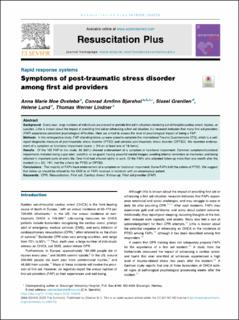| dc.contributor.author | Øvstebø, Anna Marie Moe | |
| dc.contributor.author | Bjørshol, Conrad Arnfinn | |
| dc.contributor.author | Grønlien, Sissel | |
| dc.contributor.author | Lund, Helene | |
| dc.contributor.author | Lindner, Thomas Werner | |
| dc.date.accessioned | 2023-08-16T12:11:08Z | |
| dc.date.available | 2023-08-16T12:11:08Z | |
| dc.date.created | 2023-03-29T12:04:26Z | |
| dc.date.issued | 2023 | |
| dc.identifier.issn | 2666-5204 | |
| dc.identifier.uri | https://hdl.handle.net/11250/3084399 | |
| dc.description.abstract | Background
Every year, large numbers of individuals are present or provide first aid in situations involving out-of-hospital cardiac arrest, injuries, or suicides. Little is known about the impact of providing first aid or witnessing a first aid situation, but research indicates that many first aid providers (FAP) experience persistent psychological difficulties. Here we aimed to assess the level of psychological impact of being a FAP.
Methods
In this retrospective study, FAP attending follow-up were asked to complete the International Trauma Questionnaire (ITQ), which is a self-report diagnostic measure of post-traumatic stress disorder (PTSD) and complex post-traumatic stress disorder (CPTSD). We recorded endorsement of a symptom or functional impairment (score ≥ 2/4 on at least one of 18 items).
Results
Of the 102 FAP in this study, 86 (84%) showed endorsement of a symptom or functional impairment. Common symptoms/functional impairments included being super-alert, watchful, or on guard; having powerful mental images; avoiding internal reminders or memories; and being affected in important parts of one’s life. One-third had affected ability to work. Of the FAPs who attended follow-up more than one month after the incident (n = 32), 19% met the criteria for PTSD or CPTSD.
Conclusions
The majority of FAPs have endorsement of a symptom or functional impairment. Some FAPs fulfil the criteria of PTSD. We suggest that follow-up should be offered by the EMS to all FAPs involved in incidents with an unconscious patient. | en_US |
| dc.language.iso | eng | en_US |
| dc.publisher | Elsevier | en_US |
| dc.rights | Attribution-NonCommercial-NoDerivatives 4.0 Internasjonal | * |
| dc.rights.uri | http://creativecommons.org/licenses/by-nc-nd/4.0/deed.no | * |
| dc.title | Symptoms of post-traumatic stress disorder among first aid providers | en_US |
| dc.type | Journal article | en_US |
| dc.type | Peer reviewed | en_US |
| dc.description.version | publishedVersion | en_US |
| dc.rights.holder | Copyright 2023 The Author(s) | en_US |
| dc.source.articlenumber | 100373 | en_US |
| cristin.ispublished | true | |
| cristin.fulltext | original | |
| cristin.qualitycode | 1 | |
| dc.identifier.doi | 10.1016/j.resplu.2023.100373 | |
| dc.identifier.cristin | 2138070 | |
| dc.source.journal | Resuscitation Plus | en_US |
| dc.identifier.citation | Resuscitation Plus. 2023, 14, 100373. | en_US |
| dc.source.volume | 14 | en_US |

